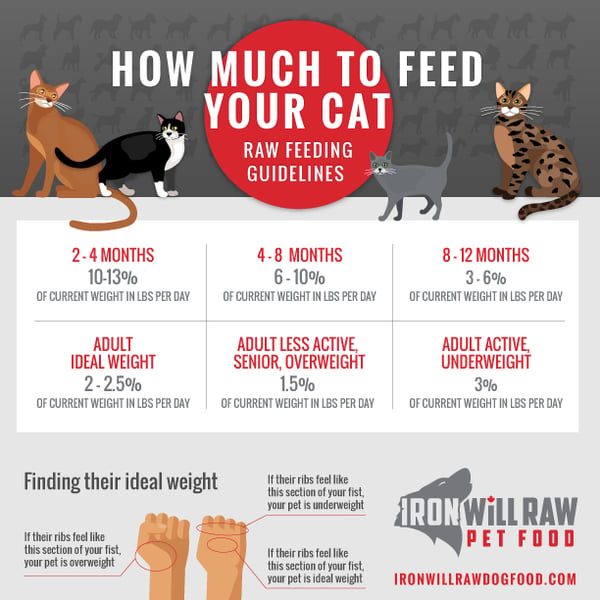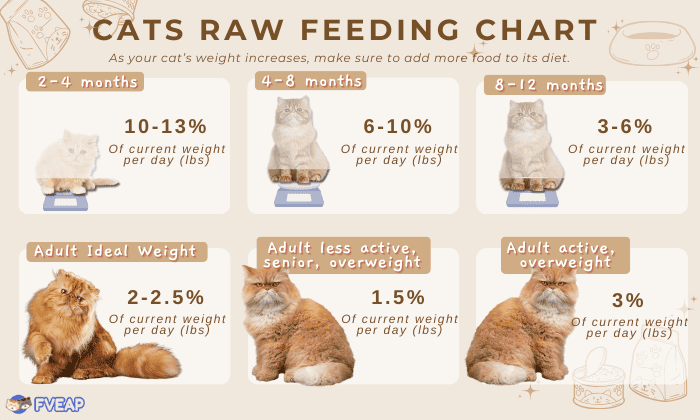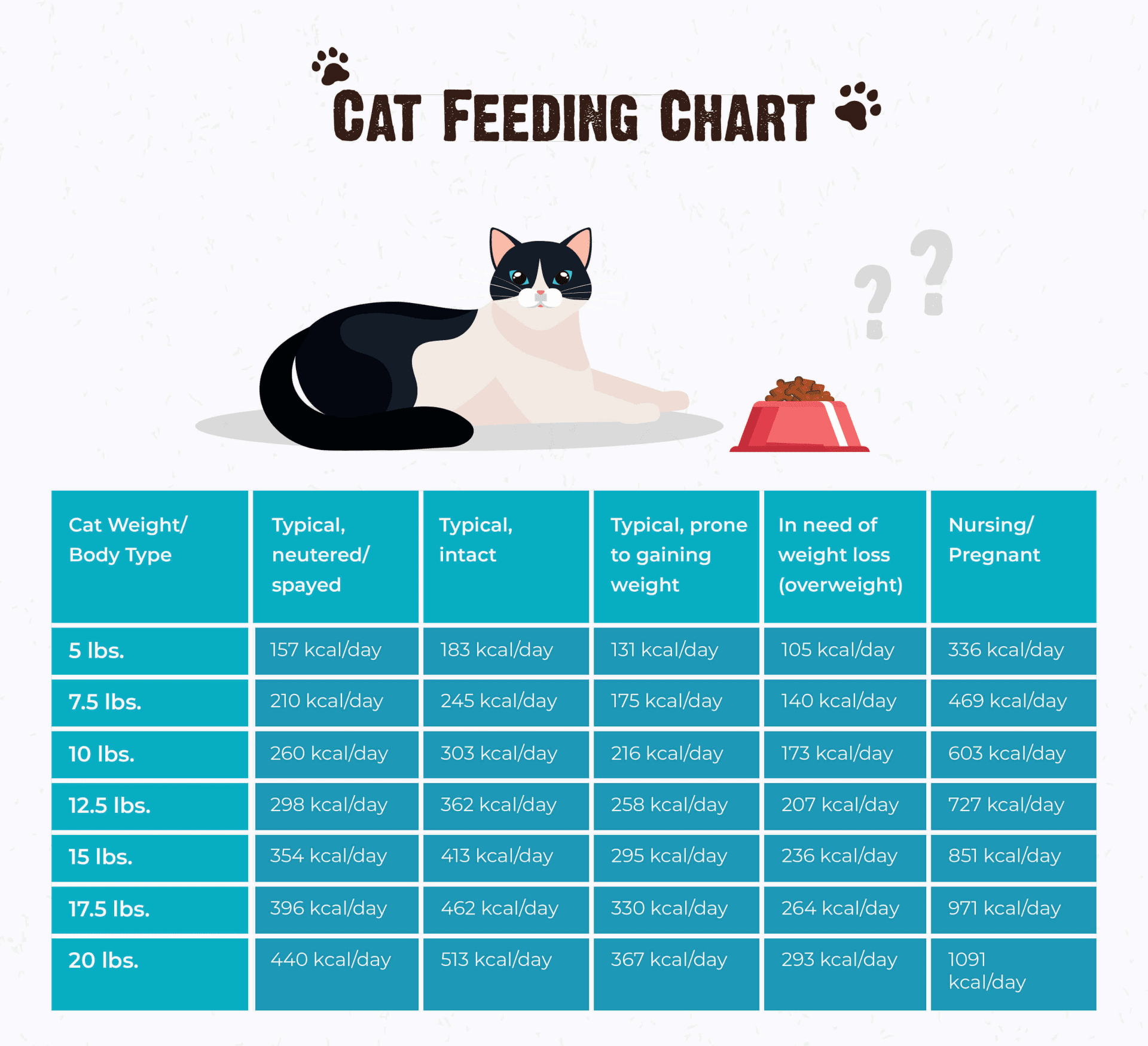Are you puzzled about how much food your 2-year-old cat should really eat? You’re not alone.
Many cat owners find themselves questioning whether they’re feeding their feline friends the right amount. Feeding your cat properly is crucial for their health and well-being, and getting it wrong could lead to weight issues or nutritional deficiencies. But don’t worry, we’re here to help you understand exactly what your cat needs.
By the end of this article, you’ll have a clear idea of how to ensure your furry companion is getting the perfect portion every day. Keep reading, because your cat’s health and happiness depend on it!

Credit: ironwillrawdogfood.com
Factors Influencing Cat’s Diet
Understanding how much food a 2-year-old cat needs can be tricky. Several factors influence a cat’s diet. Each cat is unique and has specific dietary needs. Let’s explore these factors. They help determine the ideal food amount for your feline friend.
Activity Level
Activity level plays a crucial role in a cat’s diet. Active cats burn more calories. They may require more food to stay energetic. Indoor cats usually have lower activity levels. They might need less food compared to outdoor cats. Monitor your cat’s activity to adjust its diet accordingly.
Breed Considerations
Certain breeds have specific dietary needs. Larger breeds often need more food. Smaller breeds may require less. Persian cats might have different needs than Siamese cats. Each breed has unique characteristics. These characteristics influence their diet requirements. Knowing your cat’s breed helps tailor its diet.
Health Status
A cat’s health status significantly impacts its diet. Cats with health issues may need special diets. Overweight cats might need reduced portions. Cats with digestive problems may require specific food types. Regular vet check-ups can help identify health issues. Adjust your cat’s diet based on its health status.

Credit: www.consolata.org
Daily Caloric Needs
Understanding the daily caloric needs of a 2-year-old cat is essential. It helps maintain your feline friend’s health and energy levels. Cats have unique nutritional requirements based on age, weight, and activity. Knowing how much to feed is crucial for their well-being.
Calculating Calories
To determine the right calories, consider your cat’s weight. An average 2-year-old cat weighs around 10 pounds. They typically need about 200 to 300 calories daily. This range ensures they get enough energy without gaining excess weight.
Some factors affect calorie needs. Spayed or neutered cats might need fewer calories. Their metabolism changes after these procedures. On the other hand, active cats or those with higher metabolism may require more.
Adjustments For Lifestyle
Every cat’s lifestyle influences their caloric intake. Indoor cats usually need fewer calories. They have less space to roam and play. Outdoor cats, being more active, may need more calories.
Consider your cat’s activity level. A playful cat burns more calories. Adjust their food accordingly. If your cat seems sluggish, they might need fewer calories.
Also, monitor their weight regularly. This helps ensure they stay within a healthy range. Adjust their diet if you notice weight changes. Regular veterinary check-ups can guide you on dietary adjustments.
Types Of Cat Food
Choosing the right food for your 2-year-old cat is crucial. Nutrition plays a vital role in your pet’s health and happiness. There are different types of cat food available. Knowing these types helps you make informed decisions for your feline friend.
Dry Vs. Wet Food
Dry food, or kibble, is a popular choice for cats. It’s convenient and easy to store. Kibble helps maintain dental health by reducing plaque. But it may lack moisture, leading to dehydration. Wet food contains more water, which keeps your cat hydrated. It often has a stronger aroma, attracting picky eaters. Wet food can be more expensive and spoil quickly. Balancing both types can offer the best of both worlds.
Specialty Diets
Some cats require specialty diets for health reasons. These diets address specific needs like allergies or weight control. Grain-free options are available for cats with food sensitivities. High-protein diets support active cats with greater energy needs. Senior cats may benefit from diets rich in joint-supporting nutrients. Consult your vet to find the best diet for your cat’s needs.

Credit: www.consolata.org
Feeding Schedule
Establishing a proper feeding schedule for your two-year-old cat is vital for their health and happiness. Cats thrive on routine, and a consistent feeding schedule helps maintain their energy levels and digestive health. But how do you decide the right schedule? Let’s break it down into manageable pieces: meal frequency and portion sizes. Both are equally important in ensuring your cat gets the nutrition they need.
Meal Frequency
How often should you feed your cat? Most adult cats do well with two meals a day. Feeding your cat once in the morning and once in the evening helps maintain their natural hunting instincts. Cats are crepuscular animals, meaning they are most active during dawn and dusk. This feeding schedule aligns with their natural behavior.
Do you ever notice your cat getting cranky or lethargic between meals? If so, you might want to consider adding a small snack during the day. A little treat can keep their energy levels stable and avoid any tummy rumbling.
Portion Sizes
Determining the right portion size can be tricky. You don’t want to overfeed or underfeed your cat. A good rule of thumb is to follow the guidelines on your cat food packaging, which usually recommends portion sizes based on your cat’s weight.
But remember, all cats are unique. If your cat is very active or has a larger build, they might need slightly more food. Conversely, a less active cat might need less. Have you noticed any changes in your cat’s weight or energy? Adjust their portion sizes accordingly.
Consider splitting their daily intake into two main meals with a small snack if necessary. This balance helps avoid overeating and ensures your cat gets all the nutrients they need.
Creating the perfect feeding schedule requires observation and a little trial and error. Have you found a schedule that works well for your cat? Share your experiences in the comments below and help others create a happy, healthy environment for their feline friends!
Monitoring Weight And Health
Your two-year-old cat’s health is closely tied to its diet, and monitoring its weight is a crucial aspect of ensuring it stays fit. Cats, like humans, can experience a range of health issues due to improper feeding. The right amount of food can help maintain a healthy weight and prevent problems. Let’s delve into the signs of overfeeding and underfeeding to help you find the perfect balance for your feline friend.
Signs Of Overfeeding
Overfeeding your cat can lead to obesity, which is often linked to severe health conditions like diabetes and joint problems. Is your cat lethargic or struggling with mobility? These could be signs of excess weight. A bulging belly or difficulty grooming itself due to size are clear indicators. Check if your cat feels heavier than usual when you pick it up. You can also gently press along its sides; a healthy cat’s ribs should be palpable but not visible.
Signs Of Underfeeding
On the flip side, underfeeding can result in malnutrition and weakened immunity. Is your cat looking thinner than it should? A notable loss of energy or a bony appearance might indicate insufficient food intake. If your cat is constantly begging for food or scavenging, it might be a sign it’s not getting enough nutrition. Watch for a dull coat, which can be a consequence of inadequate nutrition. Consistently monitor your cat’s weight, using a scale or regular vet check-ups, to ensure it stays within a healthy range.
How do you ensure your cat is eating the right amount? A simple adjustment in portion sizes can make a world of difference. Are you ready to take a step towards better health for your pet?
Consulting A Veterinarian
Determining the right amount of food for a 2-year-old cat can be challenging. Consulting a veterinarian ensures your cat receives proper nutrition based on its age, weight, and activity level. This guidance helps maintain your pet’s health and prevents obesity.
When determining how much food your 2-year-old cat should eat, consulting a veterinarian is crucial. Veterinarians provide expert guidance tailored to your cat’s specific needs. While feeding guidelines on pet food labels offer a general idea, they might not always fit your pet’s unique situation. Your vet will consider factors like weight, activity level, and overall health.Professional Advice
Veterinarians are trained to offer precise recommendations on your cat’s diet. They can help you decide the right amount and type of food. If your cat is gaining or losing weight unexpectedly, a vet visit can pinpoint the issue. They may suggest specific brands that align with your cat’s health requirements. My cat, Whiskers, once gained weight despite following the label instructions. A quick vet visit revealed she needed a higher protein diet.Regular Check-ups
Regular vet check-ups ensure your cat’s diet remains suitable as they age. Cats can develop new health issues that affect their dietary needs. A routine examination can catch these changes early. Think about how a minor adjustment in diet could enhance your cat’s well-being. Does your cat seem less energetic? It might be time for a vet visit to evaluate their nutritional needs. By making vet consultations a regular part of your cat’s life, you’re investing in their long-term health. These visits aren’t just for when something is wrong; they’re essential for maintaining your cat’s overall wellness. Incorporate professional advice into your cat’s diet plan. It pays off with a healthier, happier pet.Frequently Asked Questions
Should I Leave Food Out For My Cat All Day?
Leaving food out all day can lead to overeating and obesity in cats. Offer measured portions instead. Regular feeding schedules help monitor their intake and maintain a healthy weight. Fresh water should always be available. Consult your veterinarian for tailored feeding advice based on your cat’s age and health.
Why Is My 2 Year Old Cat Always Hungry?
Your cat may be hungry due to a high metabolism, insufficient diet, or underlying health issues. Consult a vet to rule out medical concerns and ensure balanced nutrition. Consider feeding smaller, frequent meals and engaging your cat in physical activities to curb excessive hunger.
Do Cats Stop Eating When They Are Full?
Cats usually stop eating once they feel full. Some cats may overeat due to stress or boredom. Always monitor your cat’s eating habits to ensure they maintain a healthy weight. Consult a veterinarian if you notice sudden changes in their eating behavior.
Proper portion control helps prevent overeating.
What Is A Normal Portion Of Cat Food?
A normal portion of cat food varies by cat size, age, and activity level. Generally, feed 24 to 35 calories per pound daily. Always consult the cat food label and your veterinarian for specific guidance. Providing fresh water alongside meals is essential for your cat’s health.
Conclusion
Feeding your 2-year-old cat properly is crucial for their health. Measure their meals and watch their weight. This helps avoid obesity or malnutrition. Consult with a vet for personalized advice. Cats need balanced nutrition for energy and growth. Choose high-quality cat food that meets their needs.
Remember, every cat is unique. Monitor their behavior and adjust portions as necessary. Regular meals ensure a happy, healthy cat. Keep their feeding routine consistent. Provide fresh water daily. Your cat deserves the best care and attention. Follow these tips for a content and thriving feline friend.
